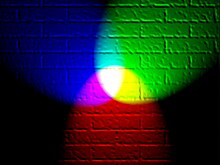
Back Toevoegende kleur Afrikaans لون جمعي Arabic Адытыўнае змешванне колераў Byelorussian Aditivna boja BS Síntesi additiva de color Catalan Aditivní míchání barev Czech Additiv farveblanding Danish Additive Farbmischung German Additive color English Síntesis aditiva de color Spanish
Additive color or additive mixing is a property of a color model. It predicts the appearance of colors made by happening together part lights, i.e. the perceived color can be predicted by summing the number-based representations of the part-related colors.[1] Modern recipes of Grassmann's laws[2] describe the additivity in the color perception of light mixtures in terms of algebraic equations. Additive color predicts perception and not any sort of change in the photons of light themselves. These predictions are only related in the limited scope of color matching experiments where viewers match small patches of uniform color isolated against a grey or black background.


The combination of two of the common three additive primary colors in equal proportions produces an additive secondary color—cyan, magenta or yellow. Additive color is also used to predict colors from overlapping projected colored lights often used in theater-based lighting for plays, concerts, circus shows, and night clubs.[3]
- ↑ MacEvoy, Bruce. "handprint : colormaking attributes". www.handprint.com. Retrieved 26 February 2019.
- ↑ MacEvoy, Bruce. "handprint : colormaking attributes". www.handprint.com. Retrieved 26 February 2019.
- ↑ David Briggs (2007). "The Dimensions of Color". Archived from the original on 2015-09-28. Retrieved 2011-11-23.